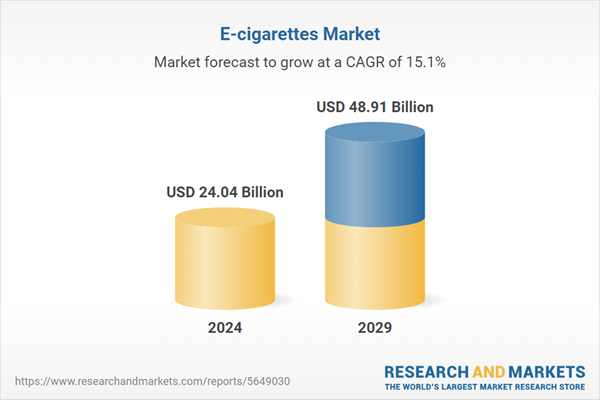The e-cigarette market is expected to grow at a CAGR of 15.06%, reaching a market size of US$48.916 billion in 2029 from US$24.047 billion in 2024.
Electronic cigarettes are less hazardous than regular cigarettes because they are made of three primary components: a vaporizer coil where e-liquid cartridges are inserted, a lithium-ion-controlled battery that powers the vaporizer, and an e-liquid cartridge that contains propylene glycol, nicotine, and flavours. These elements assist in delivering liquefied nicotine or flavoured fluids to users. With the increasing awareness of the harmful effects that come with smoking traditional cigarettes made from tobacco, e-cigarettes are quickly becoming a favourite choice among teenagers and young people.Major market players are operating in the market like JUUL Labs, Inc. has started developing products like e-cigarettes. Various products by this company include JUULpods, gadgets and different parts. This firm markets an Electronic Nicotine Delivery System (ENDS) that is aimed at supporting mature smokers in moving away from burning tobacco such as cigarettes.
E-cigarettes Market Drivers:
Increased demand due to flavour variety
There are many different taste sensations to choose from, which include either menthol, tobacco-flavoured or even fruity ones, as well as catering to an extensive clientele base. They provide certain scents as they are exhaled. Flavours are a major reason why young people use these products. The popularity of flavoured e-cigarettes among teens continues to grow, with 85% of them preferring flavours like fruit, mint, and others each year. Additionally, customer acceptance has been enhanced by the increasing cost-effectiveness of these devices, and this is likely to drive market growth until the end of the forecast period. In October 2021, the US Food and Drug Administration approved the sale of three new tobacco products, making history as an agency that, for the first time, authorized a batch of electronic nicotine delivery system products through the Premarket Tobacco Product Application path (PMTA). The market will be driven by such regulations in support of e-cigarettes.The rising awareness of e-cigarettes as they are safer than traditional cigarettes
Companies creating new products are expected to intensify the market’s expansion towards e-cigarettes. For instance, National Youth Tobacco Survey (NYTS) data show that about 2 million middle and high school students used e-cigarettes in the first six months of 2021, with a corresponding 11.3% of high school students representing the age group. Besides, the ability of manufacturers to customize this product will also drive up the usage.Further, companies have focused on increasing awareness of electronic cigarettes, particularly among adult smokers. Over the forecast period, this has been projected to help expand markets for some of the leading brands. Additionally, this article is an example of how prominent players are using different methods to capture consumer interest through launching new products that use advanced technology because they focus on attracting health-conscious clients globally.
Demand for rechargeable e-cigarettes is rising.
Rechargeable e-cigarettes will likely become more popular because they are cheap and discourage users from continuously buying cartridges. Those who make their e-liquid do not need to use prefilled cartridges. Furthermore, there has been increased use of rechargeable e-cigarettes that produce less smoke and can be charged with USB ports by teenagers in different major nations.Tobacco is expected to have a high demand in terms of flavour.
Tobacco-flavoured liquid vapour improves the taste of tobacco items by diminishing their adverse consequences, thus making them more attractive and easier to obtain for initiated non-smokers. Flavoured items, on the other hand, are driving youth usage. Fruit, candy/desserts/other sweets, mint, and menthol are the most popular flavours among youth e-cigarette users, with 85% of them using flavoured products. According to the NYTS report, the usage of menthol flavours by 30% of high school students who were discovered using e-cigarettes, which are flavour-infused.High sales in offline stores
E-cigarettes were previously sold in stores like vape shops & gas stations. Customers could choose from various devices & e-liquids at these locations. Also, stores that permit clients to test and experiment with these gadgets before concluding on a purchase selection are likely to foster retail store proliferation over the prediction horizon. Over the estimated period, the online segment is predicted to increase significantly. E-cigarette pens and vapes are purchased through the internet since it offers cheaper prices when compared to physical stores, easy accessibility or greater variety".E-cigarettes Market Restraint:
Harmful ingredients present in e-cigarettes restrain the market growth
Many studies have looked at whether e-cigarettes are safe, as they say. Researchers have found that, according to various articles, electronic tobacco sticks can produce addiction as regular ones; they equally contain harmful substances. For example, the Centre for Disease Control and Prevention (CDC) came up with a report that revealed how e-cigarette particles are full of dangerous elements such as nicotine. These devices should be avoided by kids, teenagers, pregnant women, as well as individuals with specific medical cases. More studies are required to establish the exact risks of too much use of e-cigarettes since there is little information presently available on how different they are from conventional cigarettes. This can restrain the market growth.E-cigarettes Market Geographical Outlook
North America is expected to hold a significant share of the e-cigarette market
E-cigarettes account for most tobacco products; there are currently over 3,000 e-cigarette varieties available in the US marketplace, with new tastes being added every year. In the North American market, the link of e-cigarettes with fashion appeal furthers e-cigarette demand.Among college students, cigarettes, cigars, and personal vaporizers were the next most common products, followed by snuff, hookah, smokeless tobacco, pipe tobacco, nicotine pouches, heated tobacco products, e-cigarettes, other oral nicotine products; e-cigarettes consume most tobacco products, more than 3,000 e-cigarette models exist in the US markets, and the number grows annually
E-cigarettes Market Developments:
- In June 2023, the vaping company NJOY Holdings, Inc. was acquired by Altria Group, Inc. The company will vend NJOY electronic nicotine delivery systems with the name brand NJOY, LLC, a subdivision of Altria. The distribution of NJOY products is managed by Altria Group Distribution Company.
- In June 2023, Imperial Brands plc declared the purchase of tobacco-free snacks from TJP Labs' foray into the oral sector in America. After this acquisition, US’s ITG Brands Company will be able to provide 14 different products through a packet that fared well during consumer tests. TJP Labs hopes to strengthen its dedication to creating goods that support consumer choice, flexibility, and harm reduction on a global scale using this acquisition.
Key Market Segmentation:
E-cigarettes Market is segmented and analyzed as below:By Product
- Modular E-Cigarette
- Rechargeable E-Cigarette
- Next-Generation E-Cigarette
- Disposable E-Cigarette
By Flavour
- Tobacco
- Mint
- Menthol
- Others
By Distribution Channel
- Online
- Offline
By Geography
- North America
- USA
- Canada
- Chile
- Others
- Europe
- United Kingdom
- Germany
- France
- Others
- Middle East and Africa
- Egypt
- UAE
- Others
- Asia Pacific
- China
- Japan
- Indonesia
- Philippines
- Vietnam
- Malaysia
- Others
Table of Contents
Companies Mentioned
- Philip Morris International Inc.
- Altria Group Inc. (JUUL Labs)
- British American Tobacco PLC (Reynolds American Inc.)
- Japan Tobacco, Inc.
- Imperial Tobacco Group
- Altria Group (NJOY Inc.)
- ITC Limited
- J WELL France
Table Information
| Report Attribute | Details |
|---|---|
| No. of Pages | 131 |
| Published | August 2024 |
| Forecast Period | 2024 - 2029 |
| Estimated Market Value ( USD | $ 24.04 Billion |
| Forecasted Market Value ( USD | $ 48.91 Billion |
| Compound Annual Growth Rate | 15.0% |
| Regions Covered | Global |
| No. of Companies Mentioned | 8 |









